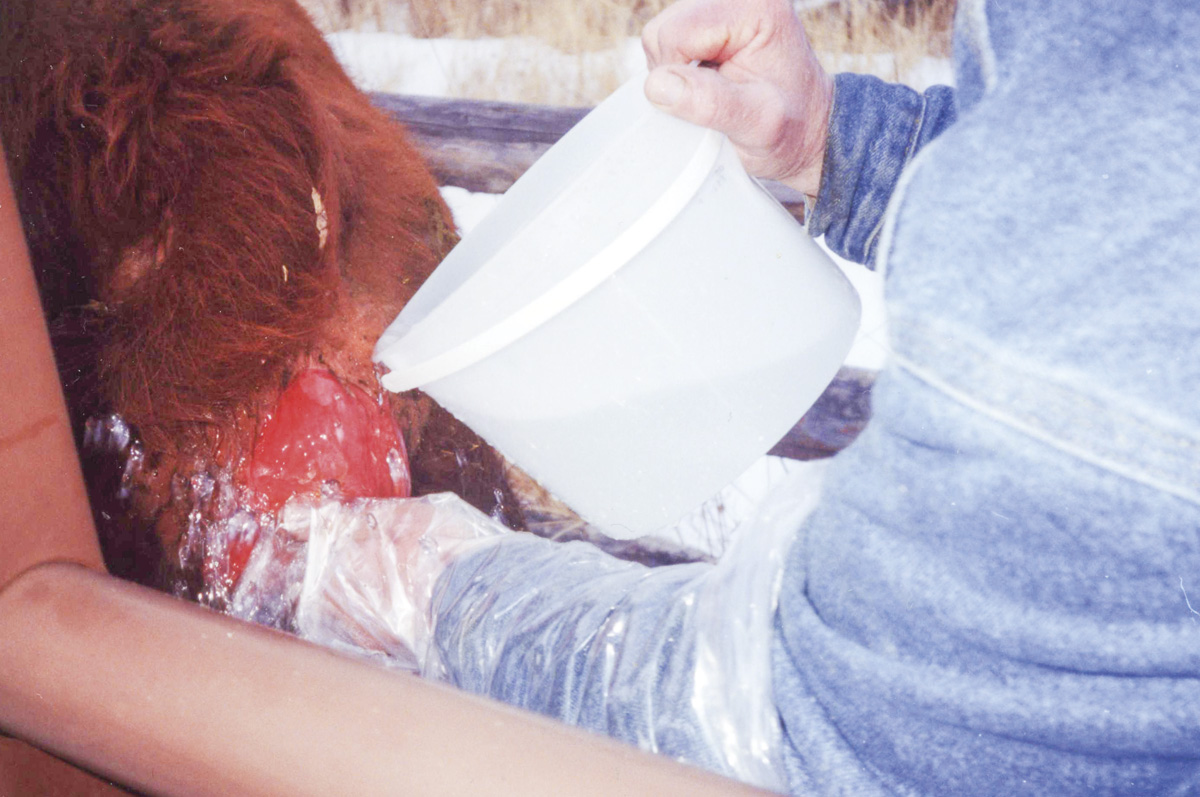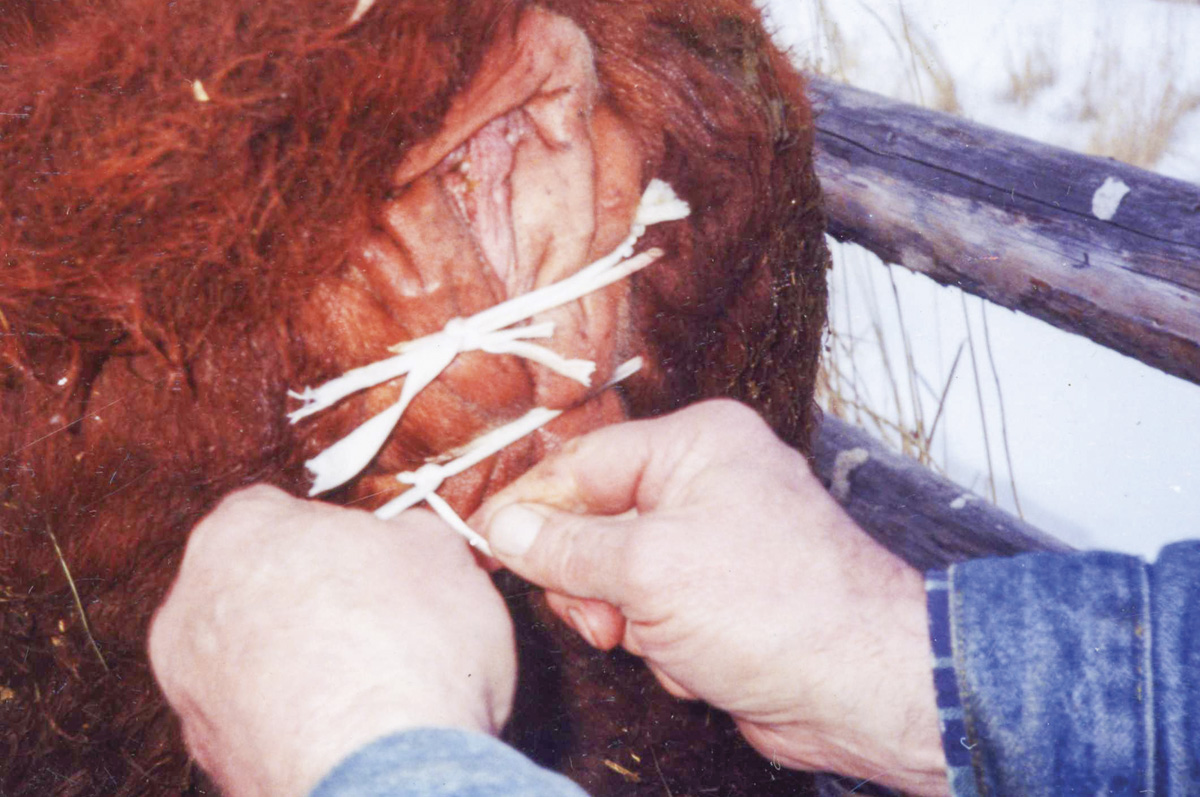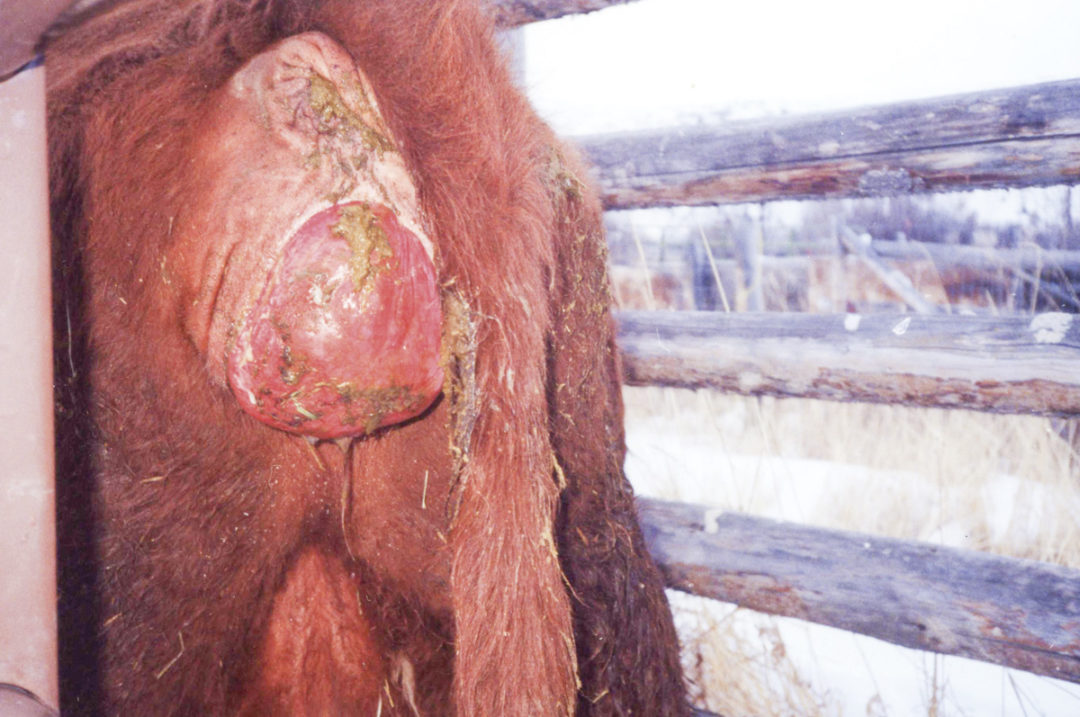There are two kinds of prolapses in cows – vaginal and uterine.
Vaginal prolapses generally occur before calving. Some cows have a structural weakness that allows part of the vagina to prolapse during late pregnancy when there is pressure in the abdomen from the increased size of the uterus. The ligaments in the pelvic region are also relaxing at that time.
When the cow is lying down (especially if her hind end is downhill), this pressure may cause vaginal tissue to prolapse. Mild prolapse (a pink bulge the size of an orange or grapefruit) will usually go back in when the cow gets up. But if she starts to prolapse each time she lies down, or strains a little when passing manure as she is lying down, these tissues may be forced out farther, to the point they cannot go back in. Sometimes the presence of a mild prolapse will stimulate the cow to strain, making the situation worse. Then she has a mass of vaginal tissue bulging out, becoming dried out and dirty.
The vaginal wall is not a sterile environment, so infection is not the primary concern. The main problem is that once these tissues are turned inside out, the blood supply is restricted, making the tissue swell. The longer it is left outside the body, the more swelling and the harder it becomes to replace. If the cow is near calving, a prolapse may make birth difficult. For these reasons, vaginal prolapses should be dealt with as soon as possible.
The prolapsed tissue must be cleaned and replaced, then kept in place with stitches across the vulva to prevent future prolapses. If she is stitched, she must be watched closely for calving, and stitches removed when she starts to calve, or she will tear them out or have difficulty calving. After the calf is born, the vagina rarely prolapses again – until the next year, when the cow gets closer to calving again. It’s best to just let the cow raise her current calf and then sell her. Once a cow prolapses, she almost always does it again, often worse the next time.

The first step is to wash or clean the prolapse before trying to reinsert it. Photo by Heather Smith Thomas.
“This is a genetic weakness,” says Dr. Dick Fredrickson, who has been a veterinarian working for Simplot for many years. Offspring from such a cow should never be kept for breeding stock.
“There are some breed differences. Herefords, for instance, tend to have the problem more often than some other breeds. In some instances, this weakness can also contribute to uterine prolapse; those cows have less structural integrity in the muscles and ligaments that hold the rectum and vulva in place,” he says.
Uterine prolapses, however, are more difficult to predict. It’s generally a one-time event for that cow and it’s OK to keep her in the breeding herd if she rebreeds on schedule.
“A uterine prolapse occurs when the cow has her calf and doesn’t stop straining, especially if she just lies there and doesn’t get up,” says Fredrickson. She may prolapse immediately after calving (the uterus comes out after the calf) or a short time later, while the cervix is still dilated. If the cow keeps straining (continued contractions and after-pains), she may push the uterus out. This can happen whether the birth was easy or difficult. The far end of one uterine horn may begin to turn inside itself, and the cow pushes against it.
“If you can get the cow up as soon as possible after she calves, or after pulling the calf, the uterus will more readily fall back where it belongs; she probably won’t prolapse, after about an hour or so. Getting her up and moving around will usually help the uterus drop back down into the abdominal cavity and straighten the uterine horns. Assuming everything else is normal, the uterus will start contracting down,” he says.
If a cow prolapses, the earlier you detect the problem, the better. The prolapsed organ is still clean and much easier to put back in, compared to trying to deal with it hours later or a day later. It’s also easier on the cow if you can replace it quickly, rather than after it’s dirty and possibly bruised and damaged.
“Usually, uterine prolapse is a one-time event and won’t happen again, but once in a while we see a cow that does it again. In that instance, there may be a genetic weakness. You should cull any cow that does it twice, and not keep heifers from her, just as you should not keep offspring from a cow that prolapses the vagina,” he says.

After the prolapse is reduced, a large suture can hold the opening together to prevent further prolapse, until the cow’s body has a chance to regain its normal tension. Photo by Heather Smith Thomas.
Replacing a prolapsed uterus can be a challenge. “If the cow is on the ground, if you can roll her upright and position her hind legs out behind her rather than underneath her, this tips her pelvis into a better angle for putting that mass of tissue back in,” Fredrickson says. In this position, gravity is working in your favor rather than against you.
“Soon after I went to work for Simplot, they had a cow prolapse, and I rolled her into that position and put that prolapse back in very easily. A cowboy who was watching said, ‘Can we get her to squeeze that back out? I want to see you do that again!’ It had taken me less than a minute, but everything was just right and the pelvis was tipped properly, and it went right back in,” Fredrickson says.
After a prolapse is replaced, you need to suture the cow to make sure she doesn’t squeeze it back out while everything is still fairly loose. “I like to use just a single suture less than a foot long, using a prolapse needle to go up one side, thread the tape through, and through the needle, and pull it down, then go in on the other side and do it the same way. You tighten that snugly so the vulva opening is only about 4 inches, about the width of your hand. Then the cow can’t prolapse again.”
If it’s a non-absorbable suture, it will stay in forever. “If you don’t cut it out, the cow can still get bred, but the next year when she calves she won’t be able to deliver the calf. You will have a serious calving problem. If you use a suture that will absorb or rot out, that won’t happen. Those aren’t as strong, however, so there are advantages and disadvantages,” says Fredrickson. Ideally, a week to 10 days later, you need to get the cow in again and cut the suture out.
If the uterus has been out several hours or a day or so before you discover it, it’s a lot harder to replace because it is swollen, dirty and damaged. “You wash it up as best you can. I usually put a little sugar on it, which pulls fluid out of the tissues, and some obstetric lubrication (which is non-toxic) if it’s really dry and dirty. If it’s badly swollen, you can massage it to get fluid out of the tissue. Those are harder to deal with. If it’s been six or eight hours or more, your chances of success goes down dramatically,” he says.
“If there’s a tear in the uterus, you need to suture it back together with catgut. If you see small intestine coming out through a hole in the tissue, you are in big trouble,” Fredrickson says. There is also a risk for severe bleeding (if a uterine artery ruptures), but this is rare. If a uterine artery bleeds, the cow will die. There are many reasons to try to take care of these problems early.



.jpg?t=1687979285&width=640)

.jpg?height=auto&t=1713304395&width=285)


